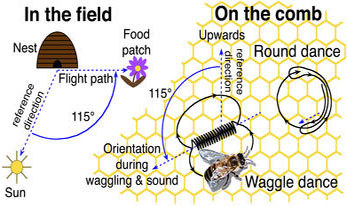Honeybees’ dance inspires more efficient Internet servers
Washington, November 17:  Researchers at the Georgia Institute of Technology have developed a honeybee dance-inspired communications system, which they claim helps Internet servers work more efficiently.
Researchers at the Georgia Institute of Technology have developed a honeybee dance-inspired communications system, which they claim helps Internet servers work more efficiently.
The new system reduces the possibility of a Web site’s becoming overwhelmed with requests and locking out potential users and customers.
In tests based on real Internet traffic, the honeybee method has been found to improve service by 4-25 per cent.
Craig Tovey, a professor in the H. Milton Stewart School of Industrial and Systems Engineering, said that he studied the efficiency of honeybees and discussed it with Sunil Nakrani, a computer science colleague visiting from the University of Oxford.
The researchers’ discussions led them to conclude that bees and Internet servers had strikingly similar barriers to efficiency.
“I studied bees for years, waiting for the right application. When you work with biomimetics (the study of how biological principles can be applied to design and engineering), you have to look for a close analogy between two systems — never a superficial one. And this definitely fit the bill, ” Tovey said.
Upon further conversations on the matter, the researchers became sure that somehow the bees’ strategies for allocating limited resources in an unpredictable and constantly changing environment could be applied to Internet servers.
Honeybees have a limited number of workers at any given time to fly out to flowers, collect nectar, return to the hive, and repeat until the nectar source is depleted. As seasons change, and during rainy days, nectar collection becomes difficult.
However, bees still manage to keep a steady flow of nectar coming into the hive by communicating with the other members of their society about the availability of nectar though their distinct dancing pattern—the direction of the dance telling which direction to fly, the number of waggle turns conveying the distance to the flower patch and the length conveying the sweetness of the nectar.
Internet servers, on the other hand, typically have a set number of servers devoted to a certain Web site or client. Sometimes constant requests from Internet users and online customers to access any particular information like a video clip or to initiate purchase, respectively, cause the server to be overloaded.
Tovey and Nakrani developed a virtual “dance floor” for a network of servers in order to deal with the overloading of servers. When one server receives a user request for a certain Web site, an internal advertisement (standing in a little less colorfully for the dance) is placed on the dance floor to attract any available servers.
The advertisement’s duration depends on the demand on the site and how much revenue its users may generate. The longer an commercial remains on the dance floor, the more power is devoted to serving the Web site requests advertised by the available servers.
The research has been published in the journal Bioinspiration and Biomimetics. (ANI)